Exploring Modern Bamboo Kitchen Cabinets
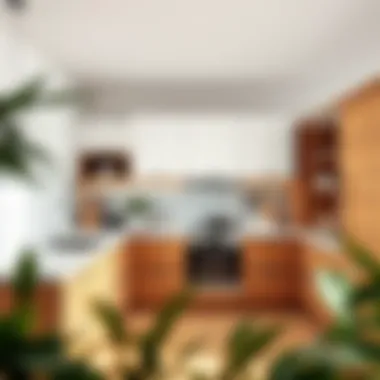
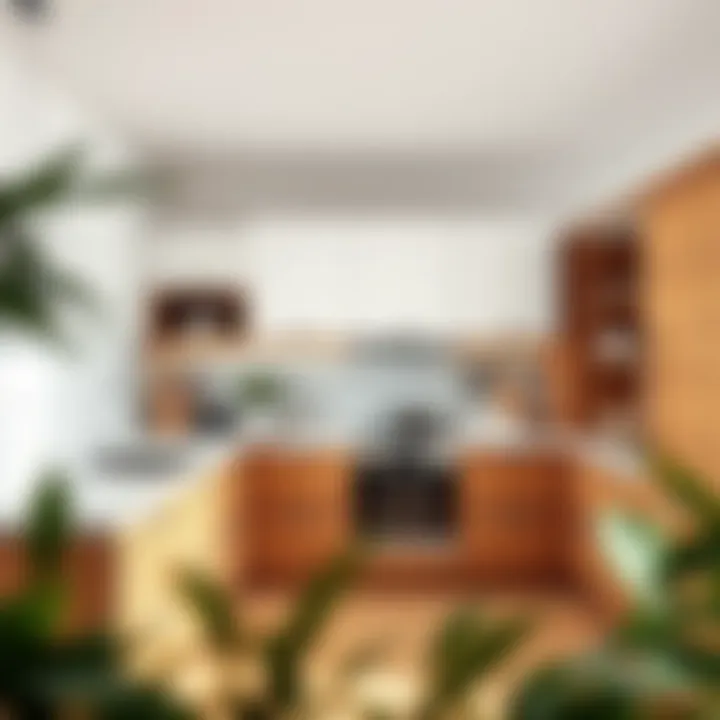
Intro
Furniture Design Trends
Current Styles and Themes
Bamboo kitchen cabinets seamlessly integrate with various design trends that are making waves in the world of home interiors. They can fit effortlessly into both modern and traditional styles. For instance, a minimalist theme benefits from the clean lines and simplicity of bamboo, while rustic designs complement the natural grain and texture of the wood.
One popular emerging style embraces a fusion of rustic charm and modern flair. Imagine cabinets that showcase the bamboo's intrinsic knots and grain patterns, set against sleek, metallic handles. This contrasts the organic with the contemporary, creating a visual dialogue that captivates the eye.
Design Flexibility
The adaptability of bamboo allows it to take on different finishes, colors, and treatments. Many homeowners opt for lighter, natural finishes that highlight the warm tones of bamboo, while others experiment with stains to create a more dramatic effect.
Color Palettes and Materials
When considering color palettes, bamboo pairs well with neutral tones like greys, whites, and earthy colors. This subtlety allows it to shine without overwhelming the senses. Pairing bamboo cabinets with materials like stainless steel or granite can also create a striking contrast, introducing a refined aesthetic.
- Light Bamboo with Crisp White Countertops
- Dark Stained Bamboo with Rich Wood Accents
- Natural Bamboo Paired with Colorful Backsplashes
Practical Furniture Tips
How to Choose the Right Size
Choosing the right size of bamboo kitchen cabinets is crucial. It's imperative to measure the available space accurately to ensure a perfect fit. Remember to consider the workflow in your kitchen; the cabinet height, depth, and width all play a role in functionality. Generally, standard cabinets are around 24 inches deep but can be adjusted based on personal preference and space available.
Measurements really make or break a kitchen layout! Making sure cabinets fit seamlessly can elevate the overall look and function.
Maintenance and Care for Longevity
Maintaining bamboo cabinets isn’t overly complicated, but it does require some attention to detail. Here are a few tips to ensure durability:
- Regular Cleaning: Wipe down your cabinets with a damp cloth. Avoid harsh chemicals that might damage the finish.
- Avoid Excessive Moisture: Due to bamboo’s natural fibers, it’s essential to keep them dry to prevent warping.
- Reapply Finish as Needed: Depending on wear and tear, applying a sealant or finish every few years can refresh the appearance and increase longevity.
Intro to Bamboo in Kitchen Design
The emergence of bamboo in kitchen design represents a refreshing shift in modern interior decor. As we become increasingly conscious of sustainability, bamboo offers a unique combination of style and environmental responsibility. This section dives into the essential aspects of bamboo's usage in kitchens and emphasizes its relevance in contemporary design.
Historical Context of Bamboo Usage
Historically, bamboo has held a significant place in various cultures, especially in Asia. Its versatility has been a boon for artisans and builders for centuries. In many regions, bamboo was not just a material but a way of life; structures made from bamboo include homes, bridges, and even furniture. The plant's rapid growth cycle and natural strength made it an ideal resource for construction and craftsmanship.
In more recent years, the western world has begun to appreciate bamboo's potential. The late 20th century marked a turning point, as environmental concerns rose and the need for sustainable resources gathered urgency. As a result, bamboo entered the realm of kitchen design, revealing itself as a chic yet practical choice for cabinets. This transition showcases bamboo as not just a trend but an enduring material, capable of offering both beauty and functionality.
Significance of Kitchen Cabinets in Interior Design
Kitchen cabinets are more than mere storage units; they are crucial components that shape the entire kitchen’s look and feel. Acting as the backbone of kitchen design, they influence the layout, accessibility, and even the mood of the space. When you step into a kitchen, the cabinets are often the first thing your eyes are drawn to.
Incorporating bamboo cabinets can greatly elevate this experience. The natural grain and texture of bamboo provide a unique aesthetic that’s both earthy and sophisticated. Homeowners are increasingly drawn to kitchens that are not just functional but also aesthetically pleasing and environmentally friendly. This is where bamboo's qualities shine, as modern designs advocate for a minimalistic appearance that seamlessly integrates with various decor styles.
"The right cabinet choice can be the difference between a kitchen that feels cluttered and one that exudes warmth and style."
As we delve further into the specifics of modern bamboo kitchen cabinets, it becomes clear that their role in kitchen design is both significant and necessary. This section sets the stage for understanding how bamboo can transform traditional kitchen spaces into modern, eco-conscious retreats.
Defining Modern Bamboo Kitchen Cabinets
When it comes to kitchen design, the cabinets often serve as the backbone of the aesthetic. They're not just functional storage spaces; they're a significant element in the overall vibe of a kitchen. With the rise in popularity of eco-friendly materials, bamboo kitchen cabinets have caught the attention of many homeowners and designers alike. This section delves into defining modern bamboo kitchen cabinets by exploring their characteristics and how they stack up against traditional woods.
Characteristics of Bamboo Material
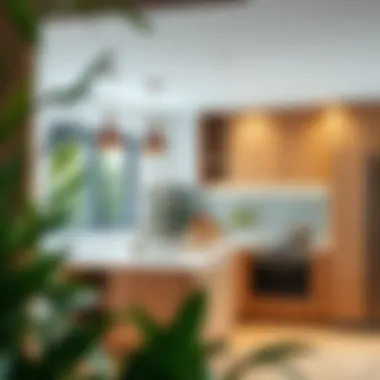
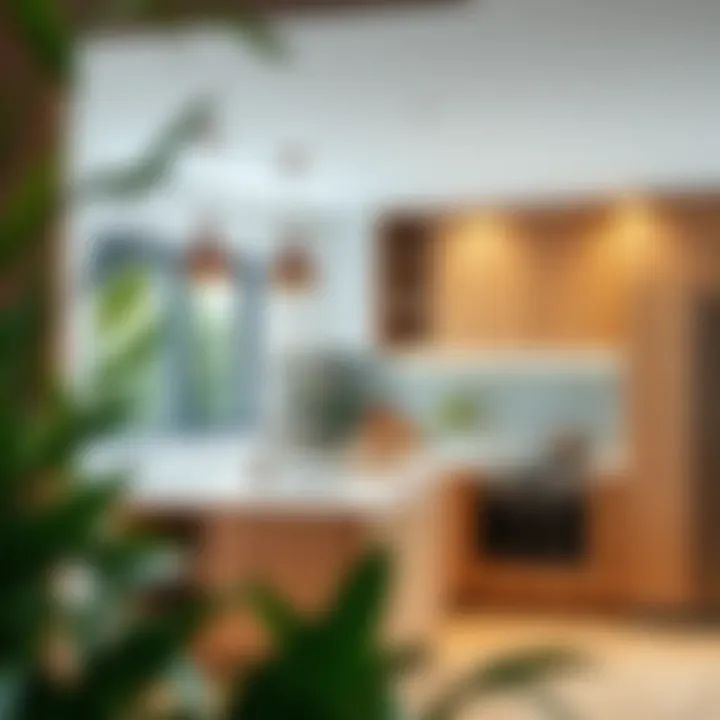
Bamboo is often mistakenly classified as a wood, but it is technically a grass. Its structural properties make it quite remarkable. Some defining features of bamboo include:
- Sustainability: Bamboo grows rapidly, reaching maturity in just 3-5 years. This rapid growth cycle allows for a quick replenishment of resources, making it a preferred choice for those aiming for sustainable living.
- Light Weight yet Strong: Bamboo is surprisingly sturdy despite being light. The tensile strength of bamboo surpasses that of many hardwoods, which means it can withstand significant wear and tear.
- Natural Aesthetic: With its unique grain and warm tones, bamboo emanates an organic charm that can seamlessly blend into various design styles—from contemporary to rustic. It offers options ranging from light, natural finishes to darker stains that bring out its depth.
"Bamboo is not just a material; it’s a lifestyle choice that reflects a commitment to sustainability and aesthetics."
These characteristics highlight the potential bamboo has to transform kitchen spaces while contributing to environmentally responsible practices.
Differences Between Bamboo and Traditional Woods
When you stack bamboo against traditional hardwoods, the differences can be startling. Let’s break it down:
- Growth Rate: While oaks and maples may take decades to fully mature, bamboo can be harvested in just a few years. This quick turnaround significantly reduces deforestation pressure on older tree species.
- Cost: Bamboo cabinets can often be more affordable than premium hardwood options. This economic factor makes bamboo not just a sustainable choice but an economically wise one, appealing to budget-conscious homeowners.
- Maintenance: Bamboo requires less upkeep compared to traditional wood cabinets. While hardwoods may need regular sealing and refinishing, bamboo's natural resistance to moisture and pests can make it a more hassle-free option.
- Stylistic Range: Traditional woods tend to have a more classic image, while bamboo offers a modern twist. Those looking to create a contemporary kitchen aesthetic may find bamboo more aligned with their vision.
In summary, defining modern bamboo kitchen cabinets is more than just a conversation about materials. It’s about embracing a sustainable, visually appealing option that meets contemporary design needs while addressing environmental concerns. As homeowners continue to explore alternatives to traditional construction materials, bamboo emerges as a clear choice that marries form and function.
Advantages of Using Bamboo Kitchen Cabinets
When it comes to modern kitchen design, the choice of cabinetry can have a profound impact on both functionality and aesthetics. Bamboo kitchen cabinets have gained traction not only for their sleek looks but also for a multitude of practical advantages that align with eco-conscious living. Homeowners, designers, and DIY enthusiasts alike are taking notice of the special features bamboo brings to the table, making it an appealing option for many.
Sustainability and Environmental Considerations
Bamboo often sits high on the list of environmentally friendly materials. As a grass, it grows incredibly fast—up to three feet in a single day under optimal conditions. This rapid growth means that bamboo can be harvested sustainably without the extensive replanting requirements that come with traditional hardwoods. Furthermore, it thrives in diverse conditions, utilizing minimal resources, which reduces the strain on our ecosystems.
Its cultivation also promotes soil health and can help combat erosion. Unlike timber, which can take decades to mature, the renewable nature of bamboo encourages responsible harvesting practices. Not to mention, bamboo absorbs more carbon dioxide from the atmosphere during its growth cycle than many conventional trees, contributing to cleaner air.
"Choosing bamboo for your kitchen cabinets isn't just a style statement; it's a step towards environmental responsibility."
Durability and Strength of Bamboo
Despite its light weight, many might be surprised to learn that bamboo boasts exceptional strength. Its tensile strength can rival that of steel in certain instances, making it highly resistant to wear and tear. This durability means that bamboo cabinets can withstand the daily hustle and bustle of a busy kitchen without succumbing to damage easily.
Bamboo's natural composition resists warping and cracking, which can be issues with traditional wood cabinets. Unlike some hardwoods that may expand or contract with changes in humidity, bamboo tends to maintain its form thanks to its tight fibers. This characteristic makes it an ideal choice for areas prone to moisture, blending both form and function seamlessly. For homeowners keen on longevity, bamboo stands as a reliable choice in kitchen cabinetry.
Aesthetic Versatility in Design
The aesthetic appeal of bamboo should not be underestimated. With its warm tones and unique grain patterns, bamboo offers a modern yet timeless look that fits well in various styles—from sleek contemporary kitchens to cozy rustic spaces. The versatility of bamboo allows homeowners to customize finishes and colors to perfectly suit their individual tastes.
Furthermore, bamboo can easily adapt to various design trends. Whether it’s used for flat-panel doors in a minimalistic setting or crafted into elaborate styles with intricate details, bamboo enhances visual interest in the kitchen. Its neutral palette complements other materials like stone and metal, making it a flexible option for mixing and matching.
In summary, the advantages of using bamboo cabinets extend beyond the visual appeal. Their sustainable characteristics, impressive durability, and aesthetic flexibility make them a worthy investment for any kitchen. Bamboo cabinet options represent a forward-thinking choice that meets the demands of modern living while also caring for the planet.
Challenges Associated with Bamboo Kitchen Cabinets
Incorporating bamboo kitchen cabinets into modern homes comes with its own set of challenges. While bamboo is celebrated for its sustainability and aesthetic appeal, potential pitfalls can arise during its usage. Addressing these challenges is pivotal for homeowners, interior decorators, and designers alike. Understanding the nuances surrounding bamboo helps ensure that the installation and maintenance yield the results one aims for. Let's dive deeper into the specific issues that might arise.
Potential Issues with Water Resistance
Bamboo, despite its impressive structure, has its vulnerabilities when exposed to moisture. While many assume bamboo naturally repels water, this is a misconception. Bamboo can absorb moisture if not properly treated, leading to warping or, worse, mold growth. While it's not as porous as some materials, over time, water can seep into joints and seams if they are not thoroughly sealed. Here are some considerations to keep in mind:
- Sealants: Utilizing high-quality sealants can help bolster water resistance. Products like polyurethane or marine-grade finishes can create a robust barrier, but they must be reapplied over time to maintain efficacy.
- Ventilation: Ensuring proper ventilation in the kitchen is fundamental. High humidity can exacerbate the water absorption issue, so fans or open windows can aid in keeping moisture at bay.
- Regular Maintenance: Periodically inspecting the cabinets for any signs of water damage can help nip problems in the bud.
"Proper treatment and care are key to extending the lifespan of bamboo cabinets, preventing them from turning into a soggy mess."
Understanding Expansion and Contraction
Wood, including bamboo, is an organic material that undergoes changes with temperature and humidity fluctuations. As bamboo absorbs moisture from the air, it expands, and similarly, it contracts when the air is dry. This expansion and contraction can lead to gaps between joints or even warping if not contemplated during design and installation. Here’s what to look out for:
- Acclimation: Before installation, bamboo cabinets should acclimate to the kitchen environment for at least 48 hours. This helps minimize expansion or contraction post-installation.
- Space Management: Leaving gaps between the cabinets and walls can also allow for slight expansion without causing damage. Failing to do so may lead to pressure points that could warp the material.
- Material Choice: Different types of bamboo may react differently to these changes. Stranded bamboo, for instance, is generally more stable than traditional bamboo boards and could be a better choice for humid environments.
In summary, the key challenges associated with bamboo kitchen cabinets ought not to deter potential users. By knowing the potential issues, we can manage and manipulate the environment effectively to harness the beauty and functionality of bamboo in kitchen spaces.
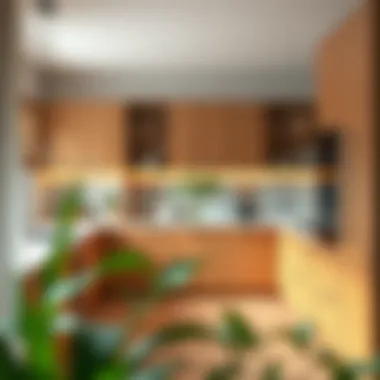
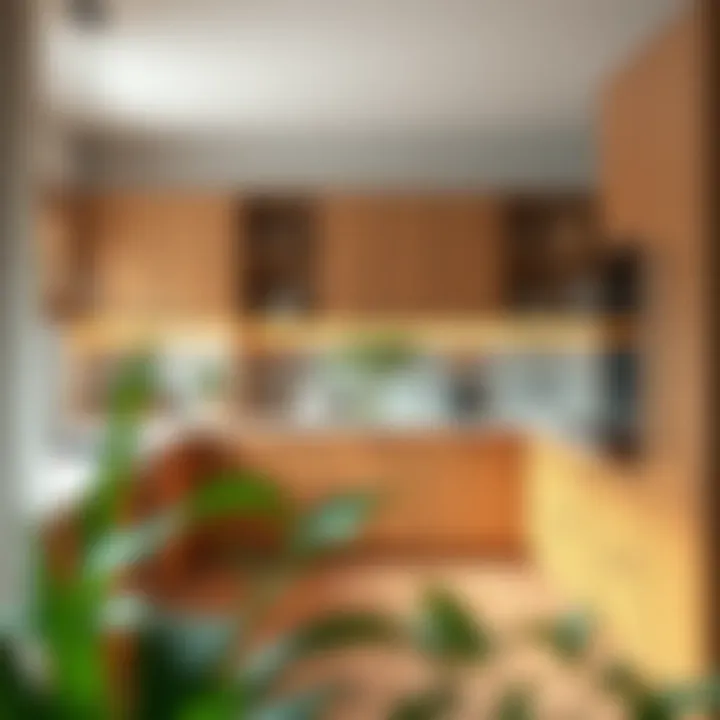
Designing with Bamboo: Styles and Trends
Bamboo is not just another material. It’s a statement piece in kitchen design today. As homeowners and designers explore sustainable options, bamboo's unique properties make it a compelling choice. This section delves into how bamboo can elevate kitchen aesthetics and functionality, examining specific elements and trends that cater to diverse tastes and styles.
Minimalist and Contemporary Approaches
Minimalism is more than just a design style; it's a mindset. It strives for simplicity and functionality. Incorporating bamboo into minimalist kitchens aligns perfectly with this ethos. The light tones of bamboo offer a clean, fresh look, promoting an airy feel. This can be instrumental in smaller kitchens where visual clutter can feel overwhelming.
In contemporary designs, bamboo cabinetry can serve as a stunning focal point. Take, for example, a kitchen with open shelving complemented by sleek bamboo cabinets. The natural grain and texture of bamboo create a harmonious balance against modern appliances and minimalist fixtures. Additionally, bamboo's adaptability to various finishes, from natural oils to painted surfaces, allows for myriad design possibilities.
- Texture Play: The natural ridges of bamboo bring depth to a flat design. This texture can be highlighted through layered lighting that casts interesting shadows at different times of the day, creating an ever-changing visual scenario.
- Color Combinations: Bamboo’s beige and light tan hues integrate seamlessly with greys and whites that dominate contemporary kitchens. Accentuating these colors with dark-colored countertops or hardware can create a captivating contrast without feeling overwhelming; however, use caution with darker shades to avoid making spaces appear cramped.
"The future of kitchen design includes the harmony of nature and simplicity. Bamboo embodies this fuller aesthetic of modern living."
Integrating Bamboo into Rustic Designs
Rustic kitchens next to the sleek modernity of minimalism create a captivating juxtaposition. Bamboo can be integrated into these warm, inviting spaces, providing an unexpected yet pleasing contrast. It adds an element of natural beauty while retaining earthy vibes that are central to traditional or rustic aesthetics.
One effective approach is using reclaimed wood alongside bamboo cabinets to establish a sense of continuity with nature. The nod to sustainability in design not only enhances the look but also resonates with eco-conscious consumers. Consider pairing bamboo with other naturally sourced materials such as stone or clay.
- Natural Finishes: Keeping bamboo in its natural state allows it to blend with rough-hewn countertops or farmhouse sinks. Using a food-safe oil can accentuate its grain, bringing warmth and character to the cabinetry.
- Color Harmony: When designing a rustic kitchen, using bamboo’s natural hues alongside muted greens or deep browns can evoke a sense of tranquility. This thoughtful color palette fosters a comforting environment and can inspire one to cook more.
Installation Considerations for Bamboo Cabinets
The installation of bamboo kitchen cabinets deserves careful attention. How these cabinets fit into your kitchen depends on multiple factors, including space, design, and the overall integrity of the cabinetry itself. Prioritizing installation considerations ensures that these modern elements don’t just look good but also function effectively for years to come. This section will delve into the various aspects that can influence a successful installation and guide homeowners through the choices they face.
Preparing the Space for Installation
Before the first cabinet is even mounted, it’s essential to prepare the space appropriately. A well-prepped area can save you from potential headaches down the road. Here’s how to get started:
- Measure Twice, Cut Once: Take accurate measurements of both the cabinets and the kitchen space. Ensure there's enough room not just for the cabinets themselves but also for appliances and workflow.
- Clear the Area: Remove any existing cabinets, appliances, or furnishings that might be in the way. A clean slate will allow you to visualize the design better.
- Check Your Walls and Floors: Ensure that the surfaces are level and free from defects. Uneven walls or floors can lead to installation challenges that might compromise the aesthetic appeal or functionality later on.
With these preparations, you create a favorable environment for the installation of your bamboo cabinets.
Best Practices for Cabinet Installation
Now that the groundwork has been laid, let’s explore best practices for installing bamboo cabinets. Proper techniques not only ensure durability but can also significantly affect the overall look and feel of your kitchen. Key considerations include:
- Use the Right Tools: Equip yourself with the necessary tools like a level, drill, and screwdrivers. Using proper tools maximizes efficiency while reducing the risk of damage to the cabinets.
- Follow Manufacturer Guidelines: Always reference the manufacturer’s instructions for specific assembly requirements. Bamboo can have its nuances, and professional guidelines help prevent missteps.
- Invest in Quality Hardware: Solid hinges and drawer slides will enhance the longevity of your cabinets. Cheap hardware often leads to performance issues that can become apparent over time.
By sticking to these best practices, you make sure that your modern bamboo cabinets get the attention they deserve during installation.
Professional Versus DIY Installation
Choosing between hiring professionals or taking the DIY route can be a tough call for many homeowners. Both options come with their advantages and disadvantages:
- Professional Installation: If you opt for professionals, you tap into their experience and expertise. They can spot potential issues ahead of time and often finish tasks more quickly than an amateur. That means less downtime for your kitchen, but it will come at a premium cost.
- DIY Installation: On the flip side, going the DIY route can be incredibly fulfilling and helps save money. However, it demands a fair bit of skill and experience. If you decide to go this route, ensure you research thoroughly and perhaps watch tutorials specific to bamboo cabinetry installation.
Ultimately, the choice between professional and DIY installation hinges on your comfort level and experience with woodworking and home improvement projects.
"A little preparation goes a long way in ensuring your new bamboo kitchen cabinets are installed correctly. Always plan ahead!"
By considering these elements, you ensure a successful transition to a modern bamboo kitchen. Previous sections laid the groundwork, and exploring installation today provides a further layer of understanding necessary for making bamboo a lasting choice in kitchen cabinetry.
Maintenance of Modern Bamboo Kitchen Cabinets
When it comes to bamboo kitchen cabinets, maintenance is crucial to ensuring they remain in excellent condition over time. Regular care is not just about keeping them clean; it's about protecting the investment you’ve made in your home and enhancing the aesthetic appeal of your kitchen. Bamboo, while durable, does require a thoughtful approach to care that can prolong its lifespan and keep it looking fresh.
An important aspect to consider is how humidity and temperature fluctuates in a kitchen environment. Bamboo can be sensitive to these changes, and proper maintenance can help mitigate potential issues before they arise. By understanding the best cleaning methods and long-term care strategies, homeowners can enjoy the beauty of bamboo cabinets for years without unnecessary wear and tear.
Cleaning Techniques and Products


Keeping bamboo cabinets clean doesn't have to be a chore, but it does require some effort using the right products. Unlike traditional hardwood, bamboo is a little different, meaning you need to be careful about the cleaning solutions you choose. Here's a brief breakdown of effective cleaning techniques:
- Gentle Cleaners: Use a mixture of mild soap and warm water. Avoid harsh chemicals, as these can strip the natural oils from the bamboo. Vinegar can also be effective, but it's best to dilute it.
- Soft Cloths: Always opt for microfiber cloths or soft sponges. These materials won’t scratch the surface, ensuring that your cabinets maintain that beautiful finish.
- Spot Cleaning: For any sticky spills, address them immediately with a damp cloth, then thorough drying to prevent water spots.
If you prefer ready-made solutions, products specifically formulated for wood might suit bamboo as well. Look for eco-friendly cleaners to keep in line with the sustainable nature of bamboo.
Long-Term Care and Preservation
Long-term care of bamboo kitchen cabinets goes beyond just cleaning. It’s about creating a routine to protect the integrity of the cabinets. Here are some key strategies to consider:
- Sealing: Applying a sealant every few years can protect the cabinets from moisture and staining. Choose a product that is specifically made for bamboo to ensure compatibility.
- Regular Inspections: Take the time to inspect the cabinets for any signs of damage, swelling, or warping. Catching these issues early can save you from expensive repairs later.
- Humidity Control: Consider using dehumidifiers in areas where humidity tends to spike. This can maintain a stable environment for your bamboo.
"Investing time in the maintenance of your bamboo kitchen cabinets not only prolongs their life but also ensures a stunning aesthetic for your kitchen space."
Taking proactive steps in both cleaning and long-term care can really help keep your investment sound and beautiful. By understanding the needs of bamboo as a material and following the guidance above, you will not only keep your cabinets looking new but also maintain their strength and functionality for the long haul.
Cost Considerations When Choosing Bamboo Cabinets
When it comes to kitchen renovation, selecting materials for cabinets plays a significant role in determining the overall project costs. Bamboo kitchen cabinets provide both aesthetic appeal and environmental benefits, but their pricing structures come with various elements to consider. Understanding the cost layout associated with bamboo cabinetry is essential for homeowners and designers alike, ensuring that expectations are realistic and aligned with budgets. This section will break down the factors influencing costs, highlighting the initial investment and comparing bamboo to alternative materials in terms of value.
Initial Investment Costs
The first hurdle many encounter is setting the budget for the initial investment in bamboo kitchen cabinets. Price ranges can often fluctuate based on various factors such as bamboo quality, finish options, and overall cabinet style. Here are some of the main components that might affect costs:
- Quality of Bamboo: There are different grades of bamboo, which directly impact price. Higher grades, like Moso bamboo, are typically more durable and thus pricier.
- Manufacturing Method: Cabinets constructed through sustainable practices might bear a higher price due to the labor intensity involved.
- Customization: If you opt for custom builds to fit unique kitchen layouts, the price could escalate significantly compared to off-the-shelf options.
- Finishing and Hardware: Often overlooked, the type of finish and hardware selected also contributes to the overall cost. High-quality finishes ensure durability, but they may cost more.
Typically, bamboo cabinets start around $100 per linear foot, but prices can soar to $300 or more for premium options or customized units. This initial investment should be weighed against the potential long-term gains of durability and environmental considerations, which often become apparent over time.
Value Comparison with Other Materials
Comparing bamboo cabinets to alternatives provides further insight into their worth. While the immediate costs may seem daunting, a long-term view reveals distinct advantages. Bamboo, while situated in similar price ranges as mid-tier hardwoods like maple or cherry, may offer better value in some scenarios:
- Sustainability: Bamboo is remarkably eco-friendly, growing much faster than traditional woods. This means you’re making an environmentally responsible choice without necessarily breaking the bank.
- Durability: Bamboo's natural strength and resilience mean that it might outlast cheaper options like particleboard or laminate, which tend to need replacing sooner, leading to additional costs over time.
- Aesthetic Appeal: Its unique look can also elevate a kitchen’s design, potentially increasing the home’s value.
In contrast to soft woods or composites, bamboo provides a great balance of aesthetics, sustainability, and strength, offering a compelling value proposition.
"Investing in bamboo isn’t just about the price tag today; it’s about understanding the layers of value it brings to your kitchen tomorrow."
Ultimately, choosing bamboo kitchen cabinets should be about aligning financial commitments with both current needs and future advantages, making for a wise decision in modern kitchen design. Homeowners should assess their priorities: whether it’s sustainability, durability, or aesthetics, bamboo cabinets often shine in multifaceted value comparisons.
Finale: Is Bamboo Right for Your Kitchen?
Determining whether bamboo is the right fit for your kitchen involves weighing its many attributes against your personal and practical considerations. Bamboo kitchen cabinets have garnered attention not only for their beauty but also for their eco-friendly nature. With the increasing emphasis on sustainability in modern design, incorporating bamboo can certainly align with both aesthetic desires and environmental responsibilities.
Evaluating Pros and Cons
When evaluating bamboo cabinets, you should consider both the strengths and weaknesses they bring to your kitchen setup.
Pros:
- Eco-Friendly: Bamboo is a renewable resource, growing rapidly and requiring less water than traditional hardwoods. This makes it a solid choice for environmentally conscious homeowners.
- Durability: Thanks to its natural strength, bamboo is surprisingly resilient, making it ideal for a high-traffic area like the kitchen.
- Aesthetic Appeal: Bamboo offers a sleek, modern look that can range from light, airy tones to deeper, richer hues, allowing for versatile design potential.
Cons:
- Water Sensitivity: While bamboo is generally durable, excessive moisture can affect its longevity, leading to warping or splitting.
- Cost Variability: Depending on the quality and treatment, bamboo can sometimes rival the cost of more traditional materials. It's important to compare prices and quality to get the best bang for your buck.
Evaluating these points helps align your choices with what truly fits your needs without jumping into a decision based solely on trends.
Making an Informed Decision
Armed with information, the next phase is making a well-rounded decision. Here are some key things to keep in mind:
- Assess Your Lifestyle: Think about how much wear and tear your kitchen will experience. If you have a busy household with kids or frequent gatherings, that durability factor comes into play.
- Design Compatibility: Consider how bamboo would mesh with your overall kitchen design theme. Whether you lean towards contemporary or rustic vibes, bamboo can adapt, but it’s crucial to visualize the final look.
- Budget Considerations: Weigh your financial options carefully. A minimal budget may lead you to lower-priced options but be cautious—quality might take a hit, affecting durability.
"Sustainability and distinct style can go hand-in-hand when it comes to modern bamboo kitchen cabinets."
In the end, choosing bamboo cabinets isn't just a matter of what's fashionable. It is about mirroring your values in your home while also considering factors like longevity and maintenance. Careful thought will ensure your kitchen serves not just as a cooking space, but as a seamless extension of your lifestyle.



